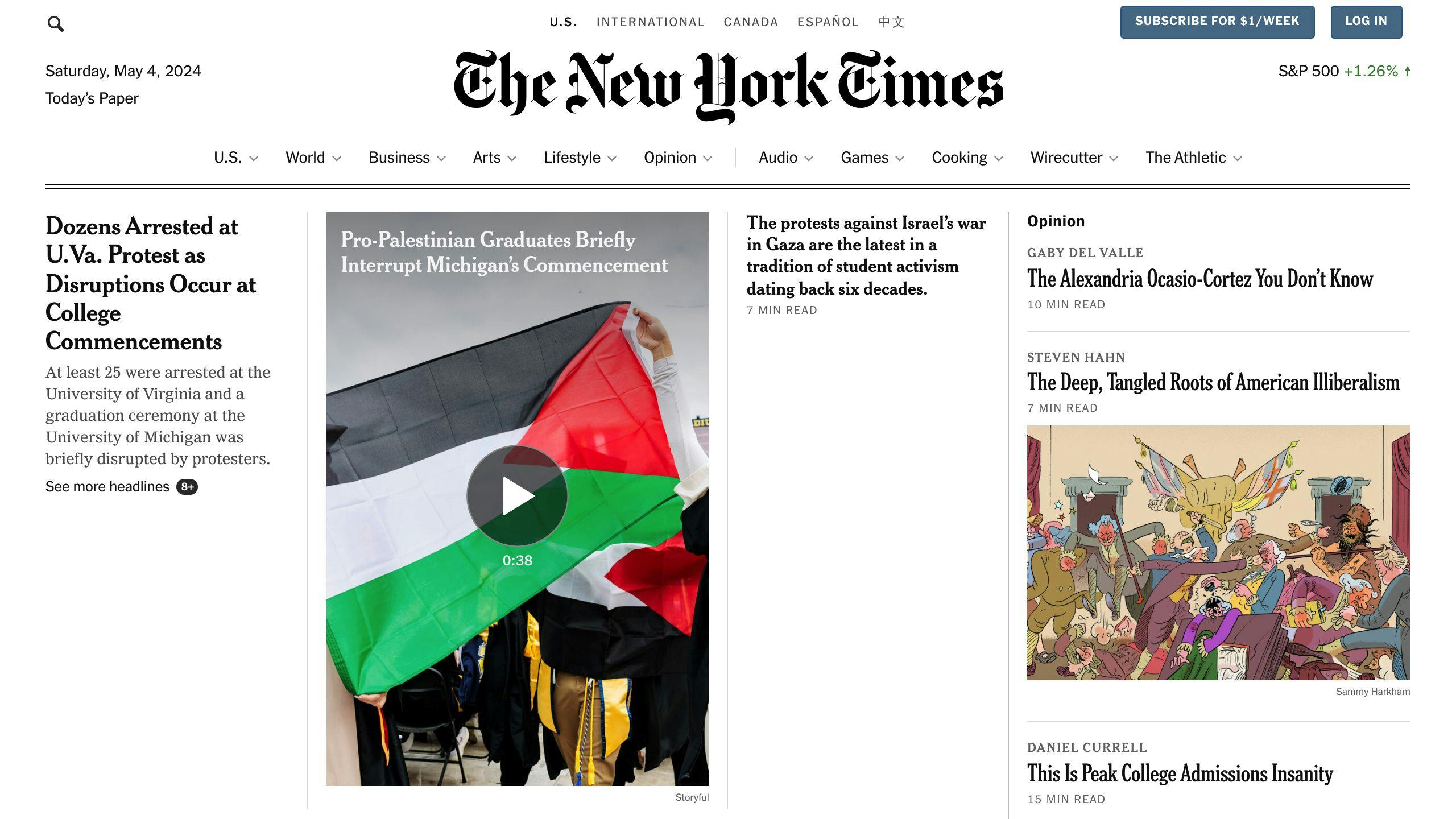Polls and quizzes are interactive content formats designed to stimulate audience participation and drive engagement. While polls are simple multiple-choice questions used to gather opinions and spark discussions, quizzes provide personalized feedback and insights, making them more suitable for lead generation and audience segmentation.
When to Use Polls
- Need immediate feedback
- Foster community discussions
- Minimal time investment required
- Enhance event engagement
When to Use Quizzes
- Encourage in-depth interaction
- Collect data on audience preferences and behavior
- Create educational content
- Offer a memorable and shareable experience
Quick Comparison
| Attribute | Polls | Quizzes |
|---|---|---|
| Purpose | Gather opinions, spark discussion | Provide personalized feedback and insights |
| Format | Simple multiple-choice questions | Interactive, often with multimedia |
| User Engagement | Encourages sharing and debate | Fosters active participation and self-discovery |
| Feedback | Typically provides aggregate results | Offers personalized feedback |
| Applications | Social media, market research | Content marketing, lead generation |
To create engaging polls and quizzes, know your audience, keep it simple, offer incentives, make it mobile-friendly, and use visuals. Measure success by tracking completion rates, time spent, social shares, and user feedback.
The choice between polls and quizzes depends on your content's purpose and desired outcome. Polls are ideal for sparking discussions and gathering opinions, while quizzes provide a more interactive and personalized experience, making them better suited for content marketing and lead generation.
Polls: Quick and Simple
Polls are a popular way to engage with your audience and encourage participation. They are easy to create and can be used to ask a single question, making them an effective way to spark conversation and increase social media interaction.
Benefits of Polls
Here are some benefits of using polls:
- Easy to create: Polls are quick to set up and share with your audience.
- Encourage participation: Polls prompt your audience to share their opinions and engage with your content.
- Gather feedback: Polls help you gather valuable insights from your target audience.
- Drive conversation: Polls can spark debates and encourage your audience to share their thoughts and opinions.
How Polls Work
Polls are simple to use and can be used in various ways:
| Use Case | Description |
|---|---|
| Gauge audience sentiment | Use polls to understand your audience's opinions on a particular topic. |
| Encourage participation | Use polls to prompt your audience to share their thoughts and opinions. |
| Gather feedback | Use polls to gather insights from your target audience. |
| Drive conversation | Use polls to spark debates and encourage your audience to share their thoughts and opinions. |
Overall, polls are a quick and simple way to engage with your audience, gather feedback, and drive conversation. Their ease of creation, simplicity, and ability to encourage participation make them an attractive option for businesses and individuals looking to boost engagement rates and create a more interactive content experience.
Quizzes: Interactive and Engaging
Quizzes are a powerful tool for engaging audiences and encouraging participation. They tap into people's natural curiosity, providing personalized feedback and insights that resonate with individuals. By leveraging interactivity, quizzes can foster a deeper connection with the audience, driving lead generation and audience segmentation.
The Benefits of Quizzes
Here are some benefits of using quizzes:
- Increased engagement: Quizzes encourage active participation, prompting the audience to share their thoughts and opinions.
- Personalized feedback: Quizzes provide tailored results, offering insights that resonate with individuals and foster a deeper connection.
- Lead generation: Quizzes can help generate leads by capturing user data and providing valuable information in exchange.
- Audience segmentation: Quizzes can help segment the audience based on their interests, preferences, and behaviors, allowing for targeted marketing efforts.
How Quizzes Work
Here are some ways quizzes can be used to engage audiences and drive participation:
| Use Case | Description |
|---|---|
| Challenge and self-discovery | Use quizzes to tap into people's natural curiosity, providing personalized feedback and insights. |
| Lead generation | Use quizzes to capture user data and provide valuable information in exchange, generating leads and driving conversions. |
| Audience segmentation | Use quizzes to segment the audience based on their interests, preferences, and behaviors, allowing for targeted marketing efforts. |
| Engagement and participation | Use quizzes to encourage active participation, prompting the audience to share their thoughts and opinions. |
By leveraging the power of quizzes, businesses and individuals can create a more interactive and engaging content experience, driving participation, lead generation, and audience segmentation.
Comparing Polls and Quizzes
When deciding between polls and quizzes, it's essential to understand their differences. Here's a breakdown of their purposes, formats, and benefits:
Comparison Table
| Attribute | Polls | Quizzes |
|---|---|---|
| Purpose | Gather opinions, spark discussion | Provide personalized feedback, insights, and entertainment |
| Format | Simple, multiple-choice questions | Interactive, often with multimedia elements |
| User Engagement | Encourages sharing, discussion, and debate | Fosters active participation, self-discovery, and exploration |
| Feedback Mechanisms | Typically provides aggregate results | Offers personalized feedback and insights |
| Typical Applications | Social media, market research, event engagement | Content marketing, lead generation, audience segmentation |
Key Takeaways
- Polls are ideal for sparking discussion, gathering opinions, and encouraging sharing.
- Quizzes provide personalized feedback, insights, and entertainment, making them perfect for content marketing, lead generation, and audience segmentation.
- By understanding the strengths of each tool, you can create engaging content that resonates with your audience and achieves your goals.
Remember, the choice between polls and quizzes depends on your content's purpose and desired outcome.
sbb-itb-bc761f5
When to Use Polls
Polls are a great way to engage your audience and encourage participation. Here are some situations where polls work best:
Immediate Feedback
Use polls when you need quick feedback from your audience. This could be during a live event, a webinar, or even a social media Q&A session. Polls help you understand what your audience thinks in real-time.
Fostering Community Discussions
Polls are perfect for sparking community discussions and debates. By asking thought-provoking questions, you can encourage your audience to share their thoughts and opinions, creating a sense of community and engagement.
Minimal Time Investment
Polls are ideal when you want to engage your audience with minimal time investment. They're quick, easy, and require minimal effort from participants, making them perfect for busy audiences.
Event Engagement
Use polls to enhance event engagement. Whether it's a conference, a meetup, or a webinar, polls can help break the ice, encourage participation, and create a more interactive experience.
Here's a summary of when to use polls:
| Situation | Why Use Polls |
|---|---|
| Need immediate feedback | Get quick insights into what your audience thinks |
| Want to foster community discussions | Encourage sharing and debate among your audience |
| Need minimal time investment | Engage your audience with quick and easy polls |
| Want to enhance event engagement | Create a more interactive experience at events |
By understanding when to use polls, you can create engaging content that resonates with your audience and achieves your goals. Remember, polls are all about sparking discussions, gathering opinions, and encouraging sharing – so use them wisely!
When to Use Quizzes
Quizzes are a powerful tool for engaging audiences and collecting valuable data. Here are some situations where quizzes are the better choice:
In-Depth Interaction
Quizzes encourage active participation, helping you understand your audience's interests, preferences, and opinions. This creates a more personalized experience.
Collecting Data
Quizzes provide detailed insights into your audience's behavior, preferences, and knowledge. You can use this data to tailor your content, improve user experience, and create targeted marketing campaigns.
Educational Content
Quizzes are an effective way to educate your audience on a particular topic. By presenting information in an engaging and interactive format, you can increase retention rates and encourage sharing.
Memorable Experience
Quizzes create a memorable experience, encouraging users to share their results on social media and discuss their findings with others. This leads to increased engagement, brand awareness, and user-generated content.
Here's a summary of when to use quizzes:
| Situation | Why Use Quizzes |
|---|---|
| Need in-depth interaction | Understand audience interests and preferences |
| Want to collect data | Gather insights into audience behavior and knowledge |
| Creating educational content | Present information in an engaging format |
| Want a memorable experience | Encourage sharing and discussion on social media |
By understanding when to use quizzes, you can create engaging content that resonates with your audience and achieves your goals. Remember, quizzes are all about encouraging participation, collecting valuable data, and creating a memorable experience.
Success Stories
Both polls and quizzes have been successful in boosting engagement. Let's look at some case studies that demonstrate their effectiveness.
Quiz Success
A popular TikToker created a 10-question quiz that explores the quiz taker's personality. The quiz was designed for teen girls and received a massive response, with many users sharing their results on social media.
Poll Success
Refinery 29 used Instagram's built-in poll feature to ask users about primary election dates. This simple yet effective poll sparked engagement and encouraged users to learn more about the topic.
Buzzfeed's Quizzes

Buzzfeed is known for its interactive quizzes, which have become a staple of the platform. One notable campaign, "What Dog Breed Are You?", partnered with Purina to promote their products subtly within the user journey. The result? Millions of impressions and high levels of engagement.
The New York Times' Polls

The New York Times has also seen success with poll-based content. Their "Australia-U.S. Candy Bar Debate" sparked lively debate and drove massive traffic to their website.
These success stories demonstrate the power of polls and quizzes in engaging audiences and creating memorable experiences.
| Platform | Content Type | Success Metric |
|---|---|---|
| TikTok | Quiz | Massive response and social media shares |
| Refinery 29 | Poll | Sparked engagement and encouraged learning |
| Buzzfeed | Quiz | Millions of impressions and high engagement |
| The New York Times | Poll | Sparked lively debate and drove traffic |
By understanding how to effectively use each format, you can create content that resonates with your audience and achieves your goals.
Creating Engaging Content
To create engaging polls and quizzes, follow these guidelines:
Know Your Audience
Understand who your audience is and what they're interested in. Use language that speaks to them, and design questions that reflect current trends and interests.
Keep it Simple
Keep your polls and quizzes easy to understand. Avoid using complex language or jargon that might confuse your audience.
Offer Incentives
Offer rewards or incentives to motivate people to participate in your polls and quizzes. This could be in the form of discounts, freebies, or even recognition on social media.
Make it Mobile-Friendly
Ensure that your polls and quizzes are accessible on mobile devices. This will ensure a seamless user experience and encourage more people to participate.
Use Visuals
Incorporate visuals such as images, videos, or GIFs to make your polls and quizzes more engaging and shareable.
Here's a summary of the guidelines:
| Guideline | Description |
|---|---|
| Know Your Audience | Understand your audience's interests and language |
| Keep it Simple | Avoid complex language and jargon |
| Offer Incentives | Motivate participation with rewards or incentives |
| Make it Mobile-Friendly | Ensure accessibility on mobile devices |
| Use Visuals | Incorporate images, videos, or GIFs to make content more engaging |
By following these guidelines, you can create engaging polls and quizzes that resonate with your audience and drive results.
Measuring Results
To determine the success of polls and quizzes, track these key metrics:
Completion Rates
Track how many people finish your poll or quiz. A high completion rate means your content is engaging and resonates with your audience.
Time Spent
Measure how much time people spend on your poll or quiz. This shows how invested your audience is in the content and how much value they get from it.
Social Shares
Count how many people share your poll or quiz on social media. This indicates that your content is worth talking about and resonates with your audience.
User Feedback
Collect feedback from users to understand what they liked or disliked about your poll or quiz. This helps you identify areas for improvement and create better content in the future.
Here's a summary of the key metrics to track:
| Metric | Description |
|---|---|
| Completion Rate | Measures how many people finish the poll or quiz |
| Time Spent | Measures how much time people spend on the poll or quiz |
| Social Shares | Measures how many people share the poll or quiz on social media |
| User Feedback | Measures what people liked or disliked about the poll or quiz |
By tracking these metrics, you'll be able to measure the success of your polls and quizzes and make informed decisions to improve their performance.
Choosing the Right Tool
When deciding between polls and quizzes, it's essential to understand your target audience and the purpose of your engagement tool. Both polls and quizzes have unique qualities that make them beneficial for audience engagement, but they serve different purposes.
Polls: Quick and Simple
Polls are ideal for gathering feedback, opinions, or preferences. They are quick, easy to create, and provide instant results. If you want to spark a conversation, gather opinions, or understand your audience's preferences, polls are the way to go.
Quizzes: Interactive and Engaging
Quizzes, on the other hand, are perfect for providing an interactive experience, challenging your audience, and encouraging sharing and discussion. If you want to create a fun, engaging, and shareable experience, quizzes are the better choice.
Understanding Your Audience
To choose the right tool, consider your audience's interests, preferences, and behavior. Ask yourself:
| Question | Description |
|---|---|
| What type of content do they engage with? | Identify their interests and preferences |
| What are their pain points or interests? | Understand their needs and concerns |
| What type of experience do they want from your content? | Determine their expectations |
By understanding your audience, you can make an informed decision on which engagement tool to use, ensuring a more effective and engaging experience for your audience.


